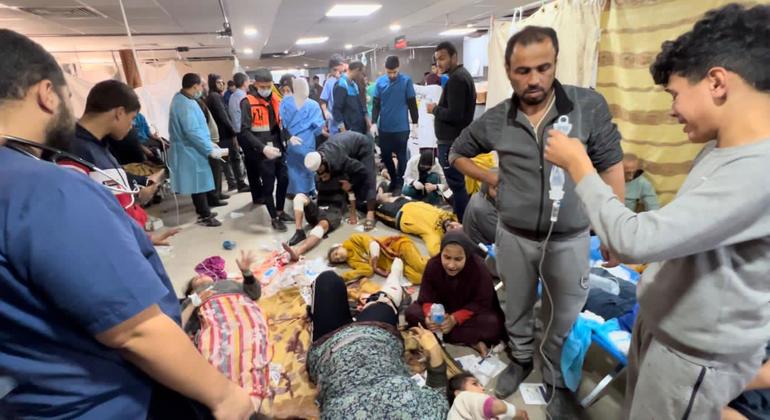|
Getting your Trinity Audio player ready...
|
The “high-risk mission”, carried out the previous day, was marked by delays at the checkpoint and severely damaged roads. Thousands of hungry civilians also surrounded the UN vehicles and fuel truck in a desperate search for food and water, further delaying the journey.
The team reported that functionality at the hospital has improved since the last humanitarian mission 10 days ago, with a significant decrease in the number of displaced people sheltering there – from 40,000 to 10,000.
Some services operational
Al-Shifa has 120 health care workers and 300 patients. Between five to 10 surgeries are conducted daily, mainly trauma cases that require immediate care.
Such essential services as basic laboratory and radiological facilities remain operational, along with emergency care, a surgical unit with three operation theatres, post-operative care and a dialysis unit. Plans are underway to re-open a nine-bed intensive care unit (ICU) in the coming days.
However, there are no maternity or pediatric services, and shortages of specialized doctors, medicines and medical supplies such as orthopedic equipment.
“These units could become operational again, but will require a consistent supply of fuel, oxygen, medical supplies and other aid,” WHO said. Furthermore, the primary oxygen plant was destroyed, and the hospital is now relying on a smaller plant.
Healthcare under fire
WHO continues to draw attention to the dire state of the healthcare system in Gaza, where 14 out of 36 hospitals remain partially functional after nearly four months of conflict.
Intensified military presence and hostilities in the south are severely obstructing the movement of health workers, ambulances and UN partners as well as their ability to resupply hospitals. Agency staff said the situation for hospitals in the city of Khan Younis is “catastrophic and indescribable”.
WHO also expressed extreme concern over reports of Al-Kheir Hospital, a small NGO-run facility, facing military incursions and several health workers being detained. Communication with the hospital is no longer possible.
Staff digging graves
Due to evacuation orders in neighbourhoods surrounding Nasser Medical Complex – the largest hospital in the south – as well as continuous hostilities in its vicinity, large numbers of wounded people are on the hospital grounds, according to Gazan health authorities.
“UK Med, an international emergency medical team deployed at Nasser, says that no one can enter or exit the facility due to ongoing bombardment close by,” the UN health agency said.
“Health staff are reported to be digging graves on hospital grounds due to the large numbers of deaths anticipated and the need to manage dead bodies. This horrifying situation should never take place in any hospital.”
WHO warned that Al-Amal Hospital is at risk of becoming non-functional, as ambulances and injured patients reportedly cannot access the facility.
The UN agency reiterated its calls for an immediate ceasefire, protection of civilians and healthcare and sustained access for the delivery of critical aid across the Gaza Strip.



